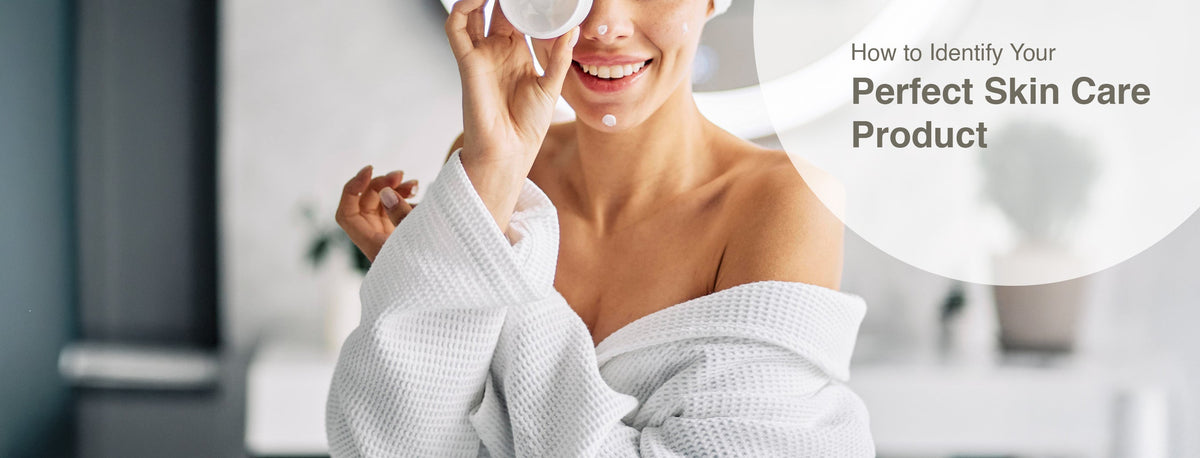How to Identify Your Perfect Skin Care Product

Introduction
Have you ever felt overwhelmed by the amount of skincare products available in a store, each promising beautiful skin? It can be quite overwhelming to sort out what works best for your skin type.
Here is the key: knowing the needs of your skin. Is your skin oily, dry, sensitive, or a mix? Are you dealing with acne, pigmentation, or fine lines? If you know these things, then you can start to weed through the mess and actually help your skin get what works.
Allow us to help you with that in this guide:
Determine your skin type and concerns.
Decode product labels.
Design a regime adapted to your needs.
No more confusion—just a real, no-nonsense approach to finding the perfect products for your skin.
In this blog we will dive in and discover how to simplify your skincare routine for glowing and healthy skin that will make your heart skip a beat!
Understand your skin type:
Knowing your skin type is where it all begins in getting the right skincare products. It may sound very simple, but your skin does change with seasonal changes, hormone levels, diet, and so on.
For example, take the case of Aditi. She finds her skin getting oily, mostly at the T-zone areas, in summer. This is indicative of oily skin. With frequent breakouts, she also feels that her pores are more visible. During this season, she needs products that control excess oil and prevent breakouts.
In the winter, her skin does feel very tight, flaking often—an indication of dry skin. The tightness and dryness mean that she needs rich moisturizers to keep her skin hydrated.
She can also have combination skin, which means that Aditi’s skin has both types. Some days, she may have an oily T-zone area and some dry patches on her cheeks; that is combination skin. When she uses a product that targets only one problem, this can make her skin even more out of balance.
In addition, she may experience a redness or irritation reaction of her skin with new products; this could be the case for sensitive skin. Otherwise, she may go through periods when her skin feels just right—not too oily or dry—to indicate normal skin.
Remember, all of these are only guidelines. Your skin may show all types of symptoms and may further vary with time. Keeping a watch on how your skin behaves to products and conditions will help in finding out what works best for you.
Identifying Personal Skin Concerns
After determining your skin type, the next step would be to zero in on the kind of skin concerns you have. Do you have acne, fight signs of aging, or maybe struggle to cope with excess oil or dry skin? Knowing how to identify these problems will help you choose products tailored to individual needs.
For instance, in case of frequent breakouts, you'll want to zero in on products with acne-fighting ingredients like salicylic acid. If you have fine lines and wrinkles, then look for anti-aging ingredients such as retinol.
Reading Product Labels
For all their complexity, product labels actually give you valuable information. Look for ingredients that speak to your specific skin issues and avoid potential skin irritants.
Key Ingredients: Hydrating hyaluronic acid, anti-aging retinol, brightening niacinamide, and acne treatment salicylic acid are just some of the ingredients to look out for.
Avoid Irritants: If you have skin that easily gets irritated, avoid fragrances, artificial colors, or harsh chemicals in products.
Patch Testing
Always do a patch test before applying a new product to your entire face. Apply a very small amount to a discreet area—behind your ear or on the inner arm—and wait 24-48 hours for adverse reactions.
Considering Your Lifestyle
It's not indifferent to the kind of life you are leading. Consider the effects of the sun, food, stress, and sleep. For example, excess sugar will only enhance acne, while lack of sleep will leave your skin washed out and tired. Make changes in your skincare routine according to the kind of lifestyle that suits you, and glow.
Experiment with different products
Finding your skincare products does take some trial and error. Be patient, and give new products time to do their magic. Most likely, the results are going to take a few weeks to start showing, so you must not get frustrated if immediately, you do not see changes.
Consult a Dermatologist
If you have been developing too many skin problems and using too many products on your body, it is recommended to consult a dermatologist. It is only then that they can be able to advise professionally and give treatments that are tailor-made for one.
Developing a Skincare Routine
Looking after your skin means you have to be consistent. Basics first: clean, tone, moisturize, protect from the sun. For the best results, personalize it based on the conditions and concerns of your skin.
Additional advice
Less is more: Start with lighter skin and add products gradually.
Listen to your skin: Observe how your skin reacts.
Quality Over Quantity : Invest in high-quality products that deliver results.
Consistency is key: Regular skincare is more important than using expensive products.
Remember, everyone’s skin is different. What works for one may not work for another. Be patient, experiment, and enjoy the process of discovering your perfect skin care routine.
Frequently Asked Questions
Q1: How do I know my skin type?
A1: Determining Your Skin Type: Pay attention to your skin in the course of a day. If your T-zone—forehead, nose, chin—is shiny, then you have oily skin. If it's tight and dry, then you have dry skin. If some areas are oily and the rest are dry, then you have combination skin. If your skin reddens or gets irritated quite easily, then you have sensitive skin. Normal skin is balanced without being too oily or dry.
Q2: What am I looking for in skincare products with regard to my concerns?
A2: Key ingredients would include Salicylic acid for acne, Retinol for anti-aging, and Hyaluronic acid for hydration. When brightening, what's really good is Niacinamide. Always look through product ingredient labels to ensure they are right for your skin type and nature of concern.
Q3: How do I effectively read product labels?
A3: Begin by screening the ingredient list. Look for ingredients that could directly address your skin issues at hand and avoid fragrances, artificial colors, harsh chemicals if you have sensitive skin. A few of the most important and really useful active ingredients would include hyaluronic acid, retinol, niacinamide, and salicylic acid.
Q4: Why is patch testing important?
A4: Patch testing allows you to see if you're going to react horribly before you apply a new product all over your face. Just apply some to an inconspicuous area—like behind the ear or on the inner arm—and leave it 24-48 hours to see how red and maddened you'll get.
Q5: How does my lifestyle affect my skin?
Q5: Sun exposure, diet, stress, and sleep significantly affect the health of your skin. For example, excessive sun exposure gives prematurity to the skin; on the other hand, high sugar intake in diet exaggerates the acne condition. Adjust this habit of skincare according to these external factors in order to suit your skin.
Q6: How much time will I need to wait to get results from new skincare products?
A6: At worst, a new skincare product could give notable changes within a few weeks. Be patient; give products time to work. If after using a product for 6-8 weeks and you are not satisfied with the result, then consider a change in products.
Q7: When should one consult a dermatologist?
A7: If your problems persist even after using a lot of products, then you definitely need to see a dermatologist. He will help you on an individual basis and prescribe the right treatment for your problems.
Q8: What is a basic skincare routine?
A8: To sum it all, the basic routine in skincare consists of cleansing, toning, moisturizing, and then sunblock application. All these should be done depending on your skin type and, at the same time, tackle some specific issues noted.


Leave a comment